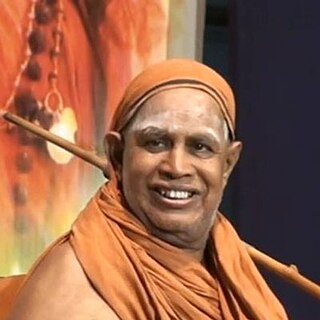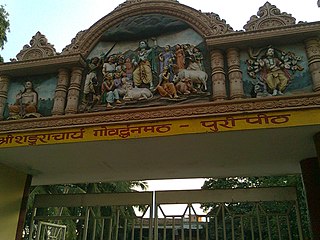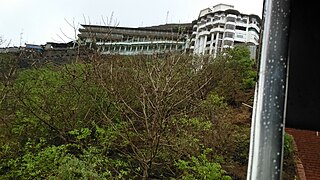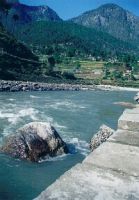
Koodli, also spelled Kudli or Kudali, is a small historic village in Shimoga District, in the Indian state of Karnataka. It is at the sangam (confluence) of two rivers, the Tunga River and Bhadra River at nearly 1,200 metres (3,937 ft). They meet here to give rise to the Tungabhadra River, a tributary of the Krishna river. Their valleys host many architectural sites. The village was a much larger town and pilgrimage center before the 14th-century, one destroyed during the Islamic conquests of the south. Important temples and their ruins here include the Jagadguru Sri Shankaracharya Dakshinamnaya Sringeri Sharada Peetham, Sangamesvara temple, Ramesvara temple, Sri Chintamani Narasimha temple, Sringeri Vediki temple, Vishwakarma temple, Sharadamba temple, Amma Devasthana, and the Brahmeswara temple. Other scattered ruins of unknown temples are also found here.

Sringeri also called Shringeri is a hill town and Taluk headquarters located in Chikkamagaluru district in the Indian state of Karnataka. It is the site of the first maṭha established by Adi Shankara, Hindu theologian and exponent of the Advaita Vedanta philosophy. Located on the banks of the river Tungā, the town draws a large number of pilgrims to its temples of Sri Sharadamba, Sri Vidyashankara, Sri Malahanikareshvara and other deities.

Shankaracharya is a religious title used by the heads of amnaya monasteries called mathas in the Advaita Vedanta tradition of Hinduism. The title derives from Adi Shankara; teachers from the successive line of teachers retrospectively dated back to him are known as Shankaracharyas.

Jagadguru Sri Jayendra Saraswathi ShankaracharyaSwamigal was the 69th Shankaracharya Guru and head or pontiff (Pïțhādhipati) of the Kanchi Kamakoti Peetham. Subramanyam Mahadeva Iyer was nominated by his predecessor, Chandrashekarendra Saraswati, as his successor and was given the pontifical title Sri Jayendra Saraswathi on 22 March 1954.
Kalady or Kaladi is a town located between Angamaly and Perumbavoor, east of the Periyar river, near to Malayattoor in Ernakulam district of Kerala, India, not far from Cochin International Airport. It is notable as the birthplace of 9th century Indian philosopher Adi Shankara.

Vidyaranya, usually identified with Mādhavācārya, was the jagadguru of the Sringeri Sharada Peetham from ca. 1374–1380 until 1386 - according to tradition, after ordination at an old age, he took the name of Vidyaranya, and became the Jagadguru of this Matha at Sringeri.

Dakṣiṇāmnāya Śrī Śāradā Pīṭham or Śri Śṛṅgagiri Maṭha is one amongst the four cardinal pīthams following the Daśanāmi Sampradaya - the peetham or matha is said to have been established by acharya Śrī Ādi Śaṅkara to preserve and propagate Sanātana Dharma and Advaita Vedānta, the doctrine of non-dualism. Located in Śringerī in Chikmagalur district in Karnataka, India, it is the Southern Āmnāya Pītham amongst the four Chaturāmnāya Pīthams, with the others being the Dvārakā Śā

Dasanami (IAST: Daśanāmī Saṃpradāya "Tradition of Ten Names"), also known as the Order of Swamis, is a Hindu monastic tradition of "single-staff renunciation" generally associated with the four cardinal mathas of the Advaita Vedanta tradition and, according to tradition, organized in its present form by Vedic scholar and teacher Adi Shankaracharya.

PascimāmnāyaŚrī Śāradā Pītham or Dwarka Sharada Math, is one amongst the four cardinal peethams established by the saint Adi Shankara to preserve and propagate Sanatana Dharma and Advaita Vedanta, the doctrine of non-dualism. Located in the city of Dwaraka, Gujarat, India it is the pascimāmnāya matha, or Western Āmnāya Pītham amongst the four Chaturāmnāya Pīthams. It is also known as the Kālikā Matha. Their Vedantic mantra or Mahavakya is Tattvamasi and as per the tradition initiated by Adi Shankara it holds authority over Sama Veda. The head of the matha is called Shankarayacharya, the title derives from Adi Shankara.

Purvamnaya Sri Govardhana Pitham or Govardhan Math is one amongst the four cardinal pithams established by the philosopher-saint Adi Shankara to preserve and propagate Hinduism and Advaita Vedanta, the doctrine of non-dualism. Located in Puri in Odisha, India, it is the Eastern Āmnāya Pītham amongst the five pithams, with the others being the Sringeri Śārada Pīṭhaṃ (Karnataka) in the South, Dvārakā Śāradā Pītham (Gujarat) in the West, Badari Jyotirmaṭha Pīṭhaṃ (Uttarakhand) in the North .It is associated with the Jagannath temple. Their Vedantic mantra or Mahavakya is Prajñānam brahma and as per the tradition initiated by Adi Shankara it holds authority over the Rigveda. The head of the matha is called Shankarayacharya, the title derives from Adi Shankara.

Jivdani Mata is a Hindu goddess whose main temple is atop a hill in Virar, Maharashtra, India.

Sri Sharadamba Temple is a famous Hindu temple dedicated to goddess Sharadamba in the holy town of Sringeri in Karnataka, India.

Saraswati P. Venkataraman Sastri , hieratically titled H.H. JagadguruShankaracharya Swami Bharatikrishna Tirtha (1884–1960), was Shankaracharya and officiating pontiff of Dwaraka Math, and then the 143rd Shankaracharya and supreme pontiff of Govardhana Math in Puri in the Indian state of Odisha, from 1925 through 1960. He is particularly known for his book Vedic Mathematics, being the first Sankaracarya in history to visit the West, and for his connection with nationalist aspirations, thus earning him the title 'Father Of The Vedic Maths'.
The Chitrapur Guru Parampara or Guru Heritage of the Chitrāpur Sāraswat Brahmins is the lineage of spiritual teachers (gurus), also known as Mathadhipatis who have led the community throughout its history.

The Tirtha lineage of Siddhayoga is a mystical sect of Shaivite Hinduism. It believes in direct encounters with life-force or kundalini shakti, and understanding of the Shastras. It places importance on the guru-disciple bond, as, according to this tradition, the guru transfers shakti, the divine energy, to the disciple through a transformative process known as Shaktipat. Shakti is said to be automatically infused into a disciple by a guru in a process called Shaktipat.

Shri Gaudapadacharya Math, also known as Kavaḷē maṭha, located in Kavale, Ponda, Goa, is the oldest matha of the Smarthan Saraswat Brahman Samaj. It was founded by Gauḍapāda around 740 AD, whose student was Govinda Bhagavatpada, the guru of Adi Shankara, a highly influential figure in Hinduism. There is also a belief that Gauḍapāda himself established the Shri Gaudapadacharya matha when he lived in Gomantak (Goa). Thus, the matha came to be known as Shri Saunstan Gaudapadacharya matha. Unlike other mathas, Shri Gaudapadacharya matha is not a polemical center established to influence the faith of all Hindus, its jurisdiction is limited to only Dakshinatya Saraswat Brahmins. The Peetadhipathi "head monk" is Śrī Gauḍapadācārya. Smartist Goud Saraswat Brahman Samaj and Rajapur Saraswat Brahmin are its main disciples.

Jagadguru Abhinava Vidyatirtha Mahaswami was the 35th Jagadguru of the Sringeri Sharada Peetham, which has been occupied by an unbroken lineage of gurus stretching back to the Advaitic philosopher Adi Shankaracharya, who established the matha for the propagation of Advaitha Vedanta.

The Advaita Guru-Paramparā is the traditional lineage (parampara) of divine, Vedic and historical teachers of Advaita Vedanta. It begins with the Daiva-paramparā, the gods; followed by the Ṛṣi-paramparā, the Vedic seers; and then the Mānava-paramparā, with the historical teachers Gaudapada and Adi Shankara, and four of Shankara's pupils. Of the five contemporary acharyas, the heads of the five Advaita mathas, four acharyas trace their lineage to those four pupils and one to Adi Shankara himself.

Uttarāmnāya Śrī Jyotish Pītham or Jyotir Math is one amongst the four cardinal pīthams established by the Ādi Śaṅkara to preserve and propagate Hinduism and Advaita Vedānta, the doctrine of non-dualism. Located in the city of Joshimath, Chamoli district, Uttarakhand, India, it is the uttarāmnāya matha or Northern Āmnāya Pītham, amongst the four Chaturamnay Peethams and in later period, Moolamnaya Sarvajna Peetham was declared as Moolamnay by disciples which is in Kalady, Kerala, birth place of Adi Shankara with the others being the Sringeri Śārada Pīṭhaṃ (Karnataka) in the South, Dvārakā Śāradā Pītham in the West and Purī Govardhanmaṭha Pīṭhaṃ in the east. Its appointees bear the title of Shankaracharya. It is the headquarters of Giri, Parvata & Sagara sects of the Dasnami Sampradaya. Their Vedantic mantra or Mahavakya is Ayamātmānam brahma and as per the tradition initiated by Adi Shankara it holds authority over Atharva Veda. The head of the matha is called Shankaracharya, the title derives from Adi Shankara.

Bharathi Tirtha Mahaswamiji, , is an Indian religious leader who is the current and 36th Shankaracharya of Sringeri Sharada Peetham, an important Hindu monastery in the tradition of Advaita Vedanta established by Sri Adi Shankara.


















